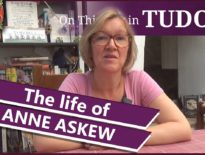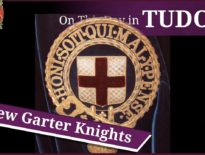On this day in Tudor history, 23rd May 1554, Elizabeth, daughter of King Henry VIII and his second wife, Anne Boleyn, arrived at the Palace of Woodstock in Oxfordshire, where she was placed under house arrest.
Elizabeth remained under house arrest there for just under a year, and she didn't make it easy for her gaoler, Sir Henry Bedingfield, and neither did her servants.
Find out why Elizabeth was under house arrest and what happened in today's talk.
Also on this day in Tudor history, 23rd May 1533, Archbishop Thomas Cranmer declared the sentence of the special court that had met at Dunstable Priory in Bedfordshire to rule on the case for the annulment of King Henry VIII’s marriage to Catherine of Aragon. Find out more about this in last year’s video:
Also on this day in history:
- 1547 - Henry Grey, 3rd Marquis of Dorset (future Duke of Suffolk) and father of Lady Jane Grey, was installed as a Knight of the Garter.
- 1572 – Burial of John Carré, entrepreneur and glass manufacturer, at Alford parish church. According to his biographer, Andrew Spicer, Carré "is credited with the re-establishment of window glass production in England and for introducing the manufacture of cristallo tableware".
- 1576 – Burial of Francis Barnham, alderman and draper, and husband of Alice Barnham, silkwoman and benefactor, at St Clement Eastcheap.
- 1591 – Death of John Blitheman, composer of organ and vocal sacred music, and tutor of John Bull. He was buried at the parish church of St Nicholas Olave, London.
Transcript:
On this day in Tudor history, 23rd May 1554, Elizabeth, daughter of King Henry VIII and his second wife, Anne Boleyn, arrived at the Palace of Woodstock in Oxfordshire, where she was placed under house arrest.
Elizabeth had been arrested on 18th March 1554 charged with being involved in a Wyatt’s Rebellion, a rebellion seeking to depose her half-sister, Queen Mary I and to replace her with Elizabeth. Elizabeth was interrogated on numerous occasions during her two month imprisonment in the Tower of London, but she was firm in her denial of involvement in the plot, and rebel Thomas Wyatt the Younger went to his death proclaiming her innocence.
Elizabeth was released on 19th May 1554, the anniversary of her mother’s execution, but she was far from free. Her gaoler Sir Henry Bedingfield and john Williams, 1st Baron Williams of Thame, were tasked with escorting her to Woodstock, where she would be kept under house arrest. She spent her a night at Richmond before setting off for Woodstock. That night was a disturbed one for Elizabeth as she feared that she would be assassinated – that would get her out of her sister’s way without her sister being held responsible. The next day, her four-day journey to Woodstock began. She spent the first night in the home of the Dean of St George’s Chapel at Windsor, the second night at the home of Sir William Dormer in West Wycombe, Buckinghamshire, and the third at Lord William’s home at Rycote in Oxfordshire. En route, Elizabeth was greeted by bells ringing, and crowds of well-wishers who gave her flowers and cakes, and at Wheatley in Oxfordshire, the whole town turned out and cried out “God save your grace!”. She was a popular princess.
The next day, the party arrived at Woodstock, where Elizabeth was to lodge in the Gatehouse, the rest of the palace having fallen into disrepair. John Nichols in his book “The Progresses and Public Processions of Queen Elizabeth”, writes of how there is a story that she used a diamond to etch three lines on the glass of the window of her apartment:
“Much suspected by me,
Nothing proved can be,
Quoth ELIZABETH prisoner
Elizabeth realised that she and her servants were going to be watched carefully during their time at Woodstock, and in a message to her servants, she referred to a verse from St Matthew’s Gospel:
“Behold, I send you forth as sheep in the midst of wolves; be ye therefore wise as serpents, and harmless as doves.”
Chronicler Raphael Holinshed wrote of how she was closely guarded at the palace, but that she was allowed to take some fresh air in the gardens. Holinshed wrote “In this situation, no marvell, if she hearing upon a time out of hir garden at Woodstocke a certain milkmaide singing pleasantlie, wished herself to be a milkmaide, as she was; saying, that her case was better, and life merrier.”
However, Bedingfield had a hard time guarding the princess. He’d been instructed to make sure that Elizabeth did not converse with any suspicious person without him being present and she was also not to receive any gifts or correspondence. Lisa Hilton, in her book “Elizabeth: Renaissance Prince” writes of how the mind of this “honest, dogged, but poorly educated man” was “no match for the quicksilver temperament of his charge”. Plus, as David Starkey points out, Elizabeth was in a gaol without any locks and most of her warders were her devoted servants.
Another issue was that Elizabeth’s cofferer, Thomas Parry, was not even lodging at the palace, he was residing at the Bull Inn at Woodstock, so was out of Bedingfield’s control. And Bedingfield couldn’t get rid of him, for the princess needed her cofferer, for she was responsible for paying her household expenses. Hilton writes of how Parry held court at the inn, having up to forty visitors a day, including members of Elizabeth’s household, and that Elizabeth caused problems for Bedingfield by receiving gifts and complaining constantly. It couldn’t have been fun for Bedingfield.
Elizabeth wanted to appeal to the queen, but Bedingfield refused to allow her to write to her. He did, however, mention it to the royal council and was informed by them that Mary was pleased that Elizabeth wanted to write to her. Elizabeth’s letter has not survived, but Mary replied to her through Bedingfield pointing out why Elizabeth had been arrested, including the fact that she’d been a figurehead of Wyatt’s Rebellion, and also pointing out the “clemency and favour” with which she had been treated. Elizabeth appealed for a trial or a meeting with the queen in which she could plead her case, or a visit from members of the council. None of which happened.
In April 1555, after nearly a year of house arrest at Woodstock, in which Bedingfield must surely have been driven mad by his charge, Elizabeth finally received a summons to court from her half-sister the queen. By this time, Mary was married to Philip of Spain and believed herself to be pregnant. With linen that she had embroidered for her new niece or nephew, Elizabeth set off for Hampton Court Palace, arriving there at the end of the month. However, she was not called to the queen, and she spent two weeks in the Prince of Wales’s Lodgings at the palace before asking to see her half-sister’s council. Bishop Stephen Gardiner led the delegation that visited Elizabeth and he asked her to submit to the queen, which she refused to do. Another week went by until Elizabeth was summoned to appear before Mary, who rebuked her for her refusal to submit, but despite this difficult first meeting, Elizabeth spent the next few months at Mary’s side.
Sadly for Mary, there was no baby. On 18th October 1555, Queen Mary I gave permission for Elizabeth to leave the royal court and travel to her own estate at Hatfield, where she was reunited with loyal servants like Thomas Parry and Catherine Ashley. She was no longer under house arrest, she was free.



Leave a Reply